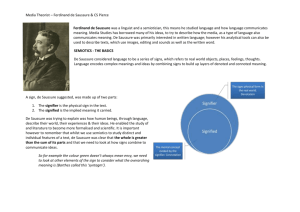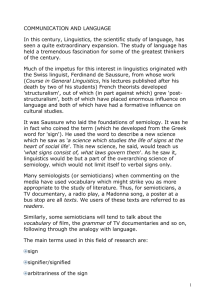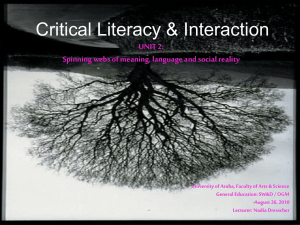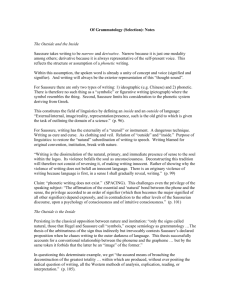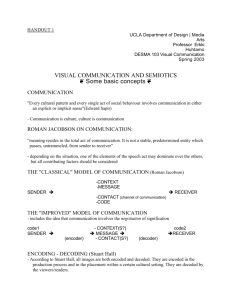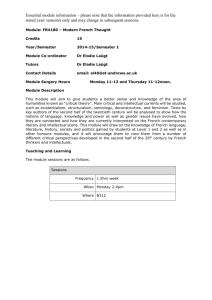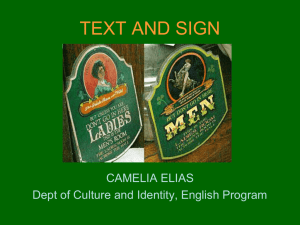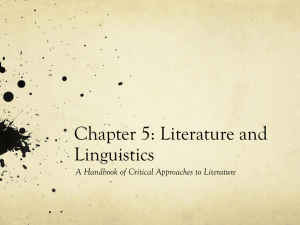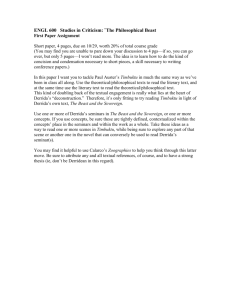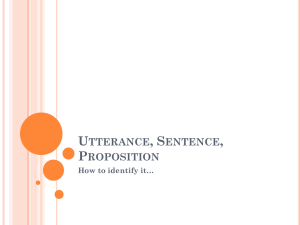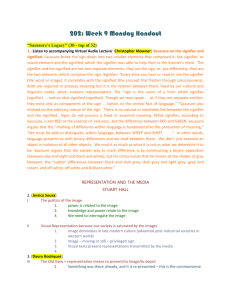powerpoint
advertisement
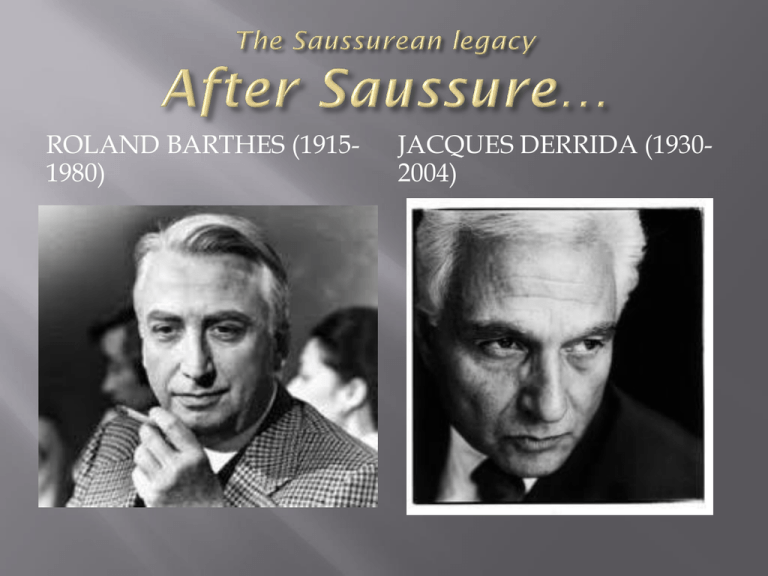
ROLAND BARTHES (19151980) JACQUES DERRIDA (19302004) Wrestling is all about using signs; the signs have no actual content The meanings of the signs of anger, pain, vengeance, triumph in wrestling are all based on conventions: they are not what the wrestlers really feel but rely on the spectators’ understanding of human emotions. The wrestlers’ gestures seem to be natural, but they are only able to communicate because they are part of a socially determined ‘structure’ (a ‘language’). These signs are arbitrary (i.e. ‘motivated’, or the opposite of ‘natural’). They are part of an elaborate code, where meanings rely on differences (like the colours of the traffic lights). The ‘suspension of disbelief’: when we watch a film, we all know it is only a performance, and still we may weep. Abbé Pierre’s ‘dishonesty’: his haircut and beard pretend to be ‘natural’, but actually they are highly artificial (a conventional set of signs) We are always conscious of the effect that the way we dress has on other people: but we try to pretend that it is natural and spontaneous. We dress the way we want other people to see us. We are responsible for the conscious choices we make The working-class audience at the all-in wrestling match is honest to itself (unlike the middle-class theatre goer): the former know wrestling is a performance and they appreciate it as such. Barthes’ critique of (French) bourgeois ideology ‘La langue est une forme et non une substance’ Substance: the undifferentiated raw material out of which language is constructed The sound waves of speech The marks of writing Meaning (in the sense of the conceptual store of thoughts, feelings, etc. which exist independently of language) Form: the abstract pattern of relationships (‘la langue’) imposed on substance by a language Semiology is a science of ‘forms’: it studies significations independently of their contents (contentless forms) Mythology: it is part of semiology (a science of forms) and of ideology (a historical science) The contents of ‘myths’ are not the domain of semiology but of ideology The connotations of a sign are ‘ideological’: they have content The semiologist sees connotations as what they are, namely ‘myths’ The semiologist is only interested in signs as ‘forms’, just as the Saussurean linguist is only interested in forms (i.e. ‘la langue’): the timeless dimension of signs Structural semiology can expose the hypocrisies of bourgeois discourse First semiolgical system (denotation – ‘noncoded’ iconic message): The denotative sign is made up of a signifier and a signified: Second semiological system (connotation – ‘coded’ iconic message): The denotative sign is also a connotative signifier (which has a connotative signified): ‘a young black soldier in a French uniform is saluting, with his eyes uplifted, probably fixed on a fold of the tricolour’ (this sign is a ‘substance’ – it pertains to parole) To a member of French society it signifies ‘that France is a great Empire, that all her sons, without any colour discrimination, faithfully serve under her flag, and that there is no better answer to the detractors of an alleged colonialism than the zeal shown by this young black soldier in serving his so-called oppressors’ (that’s an idea, a ‘substance’ – it has content) As a semiotician, who is interested in ‘forms’ or abstractions (not in contents), Barthes is able to see through the connotative sign as a ‘myth’, i.e. he is able to see that the connotation is a ‘class construct’ (of the French bourgeoisie) being passed off as a natural sign (but actually it just functions as a means to justify their bourgeois values) The process of connotation is ‘natural’ (although it is not; it is ‘coded’) and immediate when it is experienced: actually it is hard to separate denotation from connotation. Barthes sees semiology as part of linguistics (while Saussure viewed linguistics as part of semiology) ‘No visual signs are altogether nonlinguistic’ (‘the terror of uncertain signs’) Text captions ‘anchor’ the meaning of an image, or they make it move forward, a ‘relay’ (in comics, cartoons, films) when we see a wordless cartoon, and laugh out spontaneously, the sketch can only be meaningful if provided with some kind of sotto voce verbal commentary on our part The ‘languages’ of cinema, of photography, of painting, of cooking… ‘Le colt est langage’ (Mounin 1968) Every ‘serious’ semiological system has the capacity for generating its own forms of discourse (discours): that’s the domain of ‘ideology’ as having historical content (Traffic light system does not qualify, for Barthes, as a ‘serious’ semiological system) Derrida about Saussure: Saussure: ‘Language and writing are two distinct systems of signs; the second exists for the sole purpose of representing the first’. Saussure privileges speech over writing. According to Derrida, he gives the impression that the spoken signifier is somehow closer to the signified (meaning lies in the spoken ‘form’, i.e. in langue) Saussure presents a ‘scenario of purity’: the spoken sign (which contains the signified) is invaded by the contaminating force of mediation (writing as a medium) Derrida: the spoken form is not ‘pure’: it is contaminated; this contamination is made visible by writing (cf. difference vs. differance) Derrida rejects the Saussurean notion of a stable concept which the signifier designates: ‘the transcendental signified is an impossibility’. There is no ultimate meaning in words (e.g. ‘God’, ‘natural law’). Saussure: meaning is made possible within the system because of ‘difference’ (the paradigmatic relations between signs, i.e. relations in absentia) Derrida: but how can I know anything about the paradigmatic relations of the French word pronounced as ‘différence’ if I don’t know what other words I could substitute it for ? I don’t know it because, when spoken, French ‘différence’ could be two distinct words (which just happen to be pronounced in the same way) meaning ‘difference’ and ‘deferment’, respectively. Derrida: Meaning, therefore, is constantly ‘deferred’ until later because the value of a sign is not immediately present; its value is ‘deferred’ until the next sign in the syntagm ‘modifies’ it, and so on. ‘Ten green bottles standing on a wall’: does not the syntagm ‘ten green bottles’ contain the trace of the ‘wall’ which follows ? The trace is neither simply present nor absent. It is an undecidable. The song ‘ten green bottles standing on a wall’, as it is being sung right now, bears the traces of all the other previous renditions of this song, and all the future ones as well.
